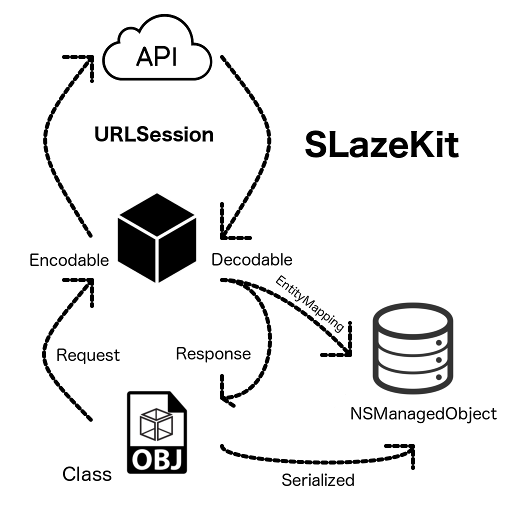SLazeKit is an easy to use Swift restful collection of extensions and classes. Don't spend hours writing your code to map your rest api request into models and coredata serialization. Stop wasting your time!
SLazeKit allows you:
- map your models by
Codableprotocol - serialize
CoreDatamodels from API response with SLazeCoreData or any other extension - fast and simple extend your models with
API&CoreData
- This request will use default configuration scheme.
- The type
ResponseModelis a result object type for result callback argument. If you want to decode array you simple execute method on[ResponseModel]type. - The
errorindicates why the request failed, or nil if the request was successful. it includeEntityMapingerrors, url preparation error and so on. If a response from the server is received, regardless of whether the request completes successfully or fails, the response parameter contains that information. - The
responseprovides tuple with HTTPURLResponse object and the data returned by the server. - The request handler is executed on the
URLSessiondelegate queue.
class func getRequest(for modelId: String, success: @escaping ((Model?) ->()), failure: (() ->())? = nil) throws {
let _ = ResponseModel.get(path: PathPattern.model.patternToPath(with: ["modelId":modelId])) { (response, result, error) in
guard response?.urlResponse?.statusCode == 200 && error == nil else {
failure?()
return
}
success(try result?.serialized(SLazeKit.newBackgroundContext()) as? Model)
}
}If ResponseModel conforms to EntityMapping protocol it will be synchronize with CoreData. That means if mode object already exist it will update it or create new instance and fill NSManagedObject with response data. You can serialize your response to receive CoreData object on given context by:
try result?.serialized(NSManagedObjectContext) as? Model)Calling this method simple query NSManagedObject which was synchronize before by given object id.
Models example
Simple Object.swift Advance Model.swift
In case of any other configuration you can use Laze
//Laze<C: LazeConfiguration, D: Decodable>
Laze<Default, ResponseModel>.get( // Default configuration, result in ResponseModel model
SLazeKit<Default>.get( // Default configuration, no result model
ResponseModel.get( // Default configuration, result in ResponseModel modelCocoaPods:
Add the line pod "SLazeKit" to your Podfile
Carthage:
Add the line github "shial4/SLazeKit" to your Cartfile
Manual:
Clone the repo and drag the folder SLazeKit into your Xcode project.
Swift Package Manager:
Add the line .package(url: "https://github.com/shial4/SLazeKit.git", from: "0.2.1"), to your Package.swift
Swift Package Manager in your iOS Project: This project demonstrates a working method for using Swift Package Manager (SPM) to manage the dependencies of an iOS project.
Example of how to use SPM v4 to manage iOS dependencies
For positive experience, you should configure SLazeKit at first.
SLazeKit in default configuration uses Default class which conforms to LazeConfiguration protocol.
I do recommand extend Default configuration. Moreover , If you have more then one API in your project. You can create as many as needed configurations schemes by creating your own object which do conform to LazeConfiguration protocol.
import SLazeKit
extension Default {
//Provide base path for your API requests.
open class var basePath: String? { return "www.yourdomain.com" }
//Additional you can set port for your requests.
open class var basePort: Int? { return 8040 }
//You can provide your own instance of JSONDecoder.
open class var decoder: JSONDecoder { return JSONDecoder() }
//You can customize instance of URLSession in here.
open class var urlSession: URLSession { return URLSession.shared }
//If you feel like to set header dor requests do it in here.
open class func setup(_ request: URLRequest) -> URLRequest {
var request: URLRequest = request
request.setValue("Your token", forHTTPHeaderField: "X-Access-Token")
request.setValue("application/json", forHTTPHeaderField: "Content-Type")
return request
}
//If you feel like to monitor response. You can do it in here.
open class func handle(_ response: HTTPURLResponse?) {
if response?.statusCode == 401 {
Client.logout()
}
}
/// Method dedicated to be use for synchronize object into persisten store
///
/// - Parameter obj: encoded object
/// - Throws: error occured during the process
open static func synchronize(_ obj: Any) {}
}Be welcome to contribute to this project! :)
Just create an issue on GitHub.
This project was released under the MIT license.




